In this issue:
Squash bug
Squash Vine Borer
Garlic bulb nematode
Tortoise beetle
Buttoning of broccoli
It is wet again. Crops that were just beginning to recover are again turning yellow because of dying roots (no air) or loss of nitrogen (see the June 6 Pest Report for a discussion of how nitrogen is lost during wet conditions).
Pests that are quite common now include the three-lined potato beetle (June 6 Pest Report), Colorado potato beetle (May 29th Pest Report), Cutworms (May 7 Pest Report), cucumber beetle (May 29 Pest Report), and most worrisome is the potato leafhopper (June 6 Pest Report).
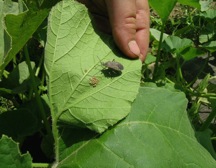 |
| Squash bug adult and eggs |
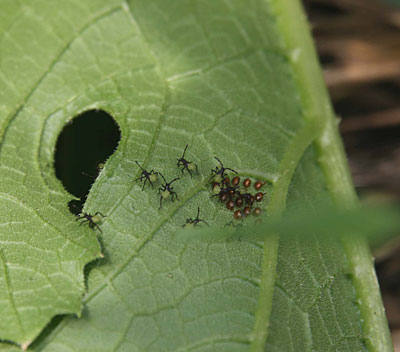 |
| Squash bug hatch |
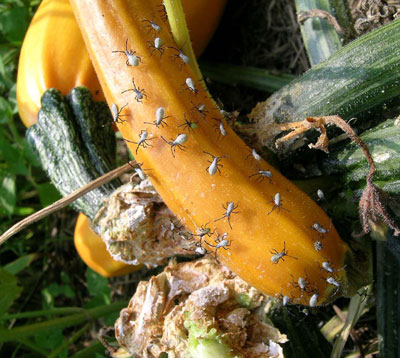 |
| Squash bug nymphs |
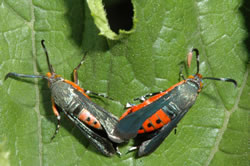  |
| Squash vine borer |
SQUASH BUG
Squash bugs are now being seen in Massachusetts, southern New Hampshire and southern Maine. Squash bugs are serious pests throughout North America. When populations are high the entire crop can be destroyed. Damage and survival are low on watermelon, very low on cucumber and muskmelon, and highest on squash and pumpkin. Both adults and nymphs feed by inserting their mouth part and sucking juices from plant tissue. Toxic saliva injected during feeding causes foliage to wilt, then turn black and die. The severity of this damage is directly related to density of squash bugs on each plant. Often I get calls from growers who believe they have a disease. Later in the season, squash bugs may feed on the fruit, causing them to collapse or become unmarketable.
Adult squash bugs are a half to three quarters of an inch long, flattened and grayish-brown. They hibernate in crop debris in and around the garden for the winter and emerge in the early summer to feed a bit but mostly interested in mating and laying eggs. Eggs are laid in clusters usually on the underside of leaves and are orange when first laid, but turn bronze-colored before they hatch. The wingless nymphs are similar in appearance to adults. They are whitish when small, with a brown head, then turn gray when larger with black legs. There is one generation per year in the Northeast. The adults that arise from these nymphs will begin looking for a winter home in the fall.
Infestation is delayed by row covers. If possible, rotate cucurbit crops between fields as far apart as possible.
Black plastic, straw mulch, and reduced tillage systems encourage higher populations, probably by providing good hiding places. Remove plastic and straw mulch at the end of the season. Squash bug numbers are reduced by clean cultivation in the fall. Keep headlands mowed and free of trash to reduce overwintering sites.
Now is the time to scout undersides of leaves for squash bug adults and eggs. In small plantings you can reduce the population greatly if you crush the eggs you find. You may not want to crush the bugs as they stink when you do.
Squash bugs are unusually difficult to control with insecticides. Time squash bug sprays to kill young nymphs just after they hatch, because this stage is the easiest to control. I suggest that you mark some egg clusters when you find them with a piece of ribbon and then watch them over a few days to note when they hatch so you catch the nymphs when they are small. Squash bug adults and large nymphs are very difficult to control, especially when the canopy becomes dense. Treat very, very early in the morning or very late in the day when the flowers are closed to reduce risk to bees.
Pyrethrum and neem products have proved effective on the young nymphs. Some recent trials of mixtures of pyrethrum and neem have shown good control. There is a new material available called Azera, which is a mixture of pyrethrum and neem. Trials with this material for squash bug are happening this year at Cornell and I look forward to the results.
(Source material for this came from the New England Vegetable Management Guide, the UMass Vegetable Newsletter, and the Resource Guide to Organic Insect and Disease Management)
Squash vine borers (SVB) are showing up in traps in N.H., and I am sure that southern Maine is next. Many vine crops are beginning to bloom, and the row covers are being taken off to allow the bees access. That means the borer now has access too. Care should be taken during bloom to avoid using insecticides when the bees are active.
Squash vine borer moths are day-flying. They have a 1.0 to 1.5 inch wingspan and bright orange markings. In flight, they look like wasps. There is one generation each year. Adults emerge in late June/early July. The moths fly slowly in zig-zags around plants and lay eggs singly on stems; eggs are usually found on the main stem near the base, but are also found on leafstalks or on the undersides of leaves. Upon hatching, larvae bore into stems (where they are protected from insecticides). Thick-stemmed squashes are preferred. Unless you use traps or scout fields for evidence of eggs or larvae, the first sign of squash vine borer infestation is often wilting vines in July and August. By that time, it is too late to do anything.
Growers should scout their pumpkin and squash fields weekly for squash vine borer from late June through early August. Examine the base of vines for eggs. The squash vine borer can be killed with an insecticide and the recommendation would be spinosad (Entrust, Monterey Garden Spray), or the Bt aizaiwi strain (Agree WG). Appropriate timing is crucial. The insecticide is most effective when applied to young larvae before they bore into the stem. Once they are in the stem the insecticide will be useless. If you see the moths flying, or hear reports from local Extension about SVB flights, or find eggs, then two insecticide sprays, ideally applied to the base of the plants and timed five to seven days apart, will control newly hatching larvae before they are able to bore into the stem.
Again, the timing is crucial and there is no point in spraying before you find evidence, or after the larvae bore into the stem.
If evidence of larval feeding (sawdust-like frass near entrance holes) is found, then split open the stem to confirm the presence of larvae, which, by the way, may suggest more eggs are being laid so scout. Borers can be removed from vines if detected before much damage is done. Slit the stem longitudinally, remove the borer, then cover the wounded stem with moist soil above the point of injury to promote additional root formation.
Some growers monitor for the moths themselves using Scentry Heliothis pheromone traps from early June through early August. If more than 5 moths per week are captured, then they make 2 to 4 weekly applications of pesticides. Timing is very important, so this is not recommended for the casual gardener.
(Source material for this from the New England Vegetable Management Guide; UMass Vegetable Newsletter, The Resource Guide to Organic Insect and Disease Management, and the SVB Report from UNH Extension’s George Hamilton)
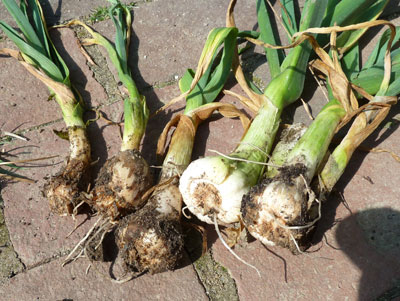 |
| Garlic bulb nematode |
GARLIC BULB NEMATODE (Ditylenchus dipsaci)
The stem and bulb nematode, also called the garlic bloat nematode, is a new garlic pest in the Northeast, first appearing in New York in 2010 and now being found throughout the Northeast. It has been spread by infested garlic seed. I am already getting reports of growers finding it in their plantings this year. The microscopic worms feed by piercing root and leaf cells with their stylet. Leaves of severely infected plants turn yellow and dry prematurely. Plants may be stunted. The roots may be missing and the basal plate may appear to have a dry rot similar to Fusarium basal plate rot.
The pest is favored by wet, cool conditions. Although the pest is not active in hot dry weather, such weather may exacerbate symptoms. The nematode survives freezing and hot weather in soil and plant debris. It can only move short distances on its own. It is primarily moved by growers either moving soil (on tools, boots, etc.), in moving water, in debris from garlic or onion, or most commonly in garlic bulbs used for seed.
Most garlic naturally shows some yellowing of the tips of older leaves, so don’t get worried right away. But, if you see some plants in your field that are significantly different than most with lots of yellowing, and they seem stunted, pull them up and check the roots. If a portion of the roots is missing, please get in touch with me and I will tell you where to send the sample for identification of this microscopic pest. DO NOT IGNORE THE PROBLEM, IT WILL GET WORSE. AND, MOST IMPORTANT, IF YOU SEE ANY, DO NOT SELL ANY GARLIC SEED. THIS COULD BECOME A MAJOR PROBLEM AND WE DO NOT WANT THAT.
Cultural Control
The best way to avoid garlic bulb nematode is to use your own garlic for seed, IF it is not yet infested. Monitor for symptoms of infestation during the growing season and submit suspect plants to a diagnostic lab for confirmation. Contact me to get instructions on how to take and where to send the sample.
If it is determined that you do have the problem, DO NOT use your own garlic for seed. Even bulbs that show no symptoms may have low levels of infestation. Obviously, do not sell any garlic for seed from a potentially infested lot. Do not replant garlic in an infested field for at least four years. Other hosts include all Alliums, celery, parsley, and salsify. Mustards, sorghum-sudan grass, and other bio-fumigant cover crops planted during the rotation period have been shown to reduce nematode populations in a field. These nematodes can survive in dry debris so carefully clean equipment and storage areas.
There are no materials that offer control.
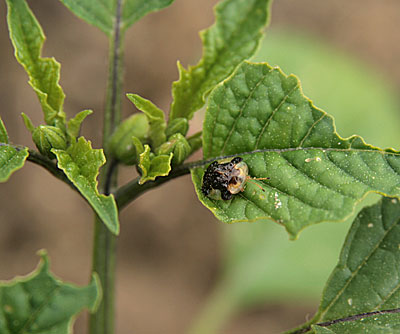 |
| Tortoise beetle |
TORTOISE BEETLE
This used to be a rare pest but this year I am getting many calls about them. Still, I do not believe that they do serious damage and do not warrant spraying. The numbers are usually very small and can be hand picked off. Of course, this could change. There is a tortoise beetle that feeds on sweet potatoes down south that is quite a serious pest.
They are oval to a square shape, clear to metallic looking with a dark square marking on the center of their back. Once you see one you will remember it. There are a few species of tortoise beetles. The one I am getting the most calls about is feeding on eggplants, tomatillos, peppers and potatoes. They overwinter as adults and come out in the mid spring. They eat holes in the leaves. When in small numbers, I recommend ignoring them or hand picking them off. If you have them in large numbers, please let me know.
BUTTONING OF BROCCOLI
Every so often in some fields of early planted broccoli, there is a plant that prematurely forms a tiny, loose head. This is called “buttoning.” It usually happens when transplants go from growing quickly in the greenhouse to slowly because of some stress at transplanting. Flowering is triggered by this stress. This year, the cold period a few weeks ago may have both slowed growth and been an additional cue to flower through residual vernalization. Required vernalization by some species is a natural adaptation through which plant flowering is promoted by exposure to the prolonged cold of winter. This adaptation ensures that reproductive development and seed production occurs in spring and summer, rather than in autumn. Vernalization usually plays a minor role with broccoli, both because of its cooler growing season and because the vernalization response is fairly weak compared to other crops. Buttoning can also be caused by other stresses including hardening-off too quickly before transplanting, excessively wet or dry soil conditions, low soil nutrient levels, or high pressure from weeds, insects, or disease. Early season varieties are usually more susceptible to buttoning and bolting.
(Adapted from an article by Christy Hoepting, Vedge Edge Weekly: June 12, 2013, Cornell Vegetable Program)
